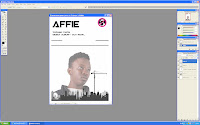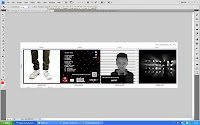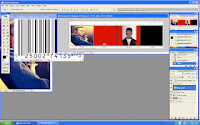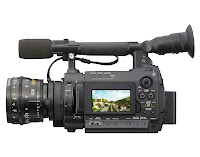Affi
Hector, Jake Karis and MiMi
Sound and considerate understanding of the technologies used in production of the video, for example in terms of set design quality and the use of FCP to create ‘earthquake’ effects.
There are evident links between creative decision making and use of technology on both productions of the video using professional digital cameras and in the post production editing process – in discussion of match of action, lip syncing and graphic matching – in glitch effects and blinder lights in production. This is sustained and thorough and accurate in discussion of the branded themes of the MV of urbanism and a social realist feel.
The commentary shows a discrete awareness of the use of new media technology and uses discriminating examples really well, particularly to selection and construction of narrative, using masks and editing techniques, such as cross cutting and the pacing used. Excellent command of terminology and well presented – understands and discusses convergence really well if implied in the commentary.
There is sustained justified decision making links between the technologies used the product and audience reception in terms of the Grime genre. Recognises the need to account for errors in the post production stage.
This is a well considered documentary, well done and Well presented work.
Friday, 10 February 2012
Directors feedback on how we used new media technologies
This video above discusses how as a group we used new media technologies in the construction, research, planning and evaluation stages.
what we didn't discuss in the video was the use of Photoshop and the design of our CD digipak and music poster. I will be discussing this below in detail.
Firstly we used Mac technology software, final cut pro in order to edit the video, this consisted of selecting and arranging various clips we had shot. We used final cut pro in order to edit the shots to cut to the beat of the music track. http://www.apple.com/finalcutpro/top-features/
Although a more important tool we used for our posters and digipaks was photoshop.
Using photoshop enabled us to manipulate images and graphic design. By working in layers and using digital tools, it allowed us to dramatically transform images into posters and digipaks. We used photoshop as it allowed us to be creative designers, as we could revise our photos, edit images, use layers and enhance quality and definition. Also the use of colours and filters enabled us to play around to find the correct balance of excitement relevant to our artist. We wanted to create a digipak and poster that would be bold and Bright, and not only give a statement but send the message across of where Affie belongs in his inner city world. As you can clearly see with our promotional poster, we played around with using black and white, all over but then contrasting the headliens and titles with a bold Font in order for them to stand out. We added climpses of colour by the recording company, and introducing new media technologies such as facebook, twitter etc.
http://en.wikipedia.org/wiki/Adobe_Photoshop

 Here is a print screen of me editing my promotional poster, we cleverly used photoshop which allowed us to edit images and use layers in order to build up a final design. Although it was a time consuming project, it required effort and precision as before we started editing we had to come up with designs which would attract customers and our target audience. We changed our idea from using colour to changing our design completely and doing a black and white theme throughout. Although we added colour through icons and symbols such as the facebook and twitter logo. In order for our target audience to connect to Affie and find out more about him daily and accessibly. I feel that our promotional poster still needs a lot of work done as it dosen't feel creative or professional enough. Thats why as a group we will sit down and adjust the design elements before we finalize it. I feel it is too empty and needs something else going on, possibly to fill the white background spaces.
Here is a print screen of me editing my promotional poster, we cleverly used photoshop which allowed us to edit images and use layers in order to build up a final design. Although it was a time consuming project, it required effort and precision as before we started editing we had to come up with designs which would attract customers and our target audience. We changed our idea from using colour to changing our design completely and doing a black and white theme throughout. Although we added colour through icons and symbols such as the facebook and twitter logo. In order for our target audience to connect to Affie and find out more about him daily and accessibly. I feel that our promotional poster still needs a lot of work done as it dosen't feel creative or professional enough. Thats why as a group we will sit down and adjust the design elements before we finalize it. I feel it is too empty and needs something else going on, possibly to fill the white background spaces.
 As well as our poster, we also used photoshop in order to create our digipak, this was a more challenging task as there were four panels rather than one. And each panel had to be different and link back to the music video itself or have some contextual meaning behind it, which would leave the audience questioning the artist himself. Here are some print screens of the process we took into making the Digipak. We choose four different pictures, one was the blinder lights which created a mysterious silhouette, another was the starcloth we used in order to potray affies in his own world, possibly space or somewhere no one else knows.
As well as our poster, we also used photoshop in order to create our digipak, this was a more challenging task as there were four panels rather than one. And each panel had to be different and link back to the music video itself or have some contextual meaning behind it, which would leave the audience questioning the artist himself. Here are some print screens of the process we took into making the Digipak. We choose four different pictures, one was the blinder lights which created a mysterious silhouette, another was the starcloth we used in order to potray affies in his own world, possibly space or somewhere no one else knows. The front panel of Affie in prison, is the mug shot this was very difficult to accomplish and required many layers on photoshop. We also added effects to the picture of Affie and adjusted the contrast and exposure of the pictures in order for them to stand out and be obvious to the target market.
The front panel of Affie in prison, is the mug shot this was very difficult to accomplish and required many layers on photoshop. We also added effects to the picture of Affie and adjusted the contrast and exposure of the pictures in order for them to stand out and be obvious to the target market. At this stage of my Alevel course, i feel i have used a more advanced level of photoshop than i did last year, with my as course, this was due to using more buttons than the basic ones in order to produce a higher standard digipak.
Wednesday, 8 February 2012
Evaluation task 4- pre production
Media technology played a very important part of all process within my media production, particular in pre production. In digital video, photography, television and film, pre-production refers to the tasks that must be completed or executed before filming or shooting begins. This includes tasks such as hiring actors or models, building sets, budgeting, planning, scheduling, renting equipment and tests, to name a few of the many pre-production tasks.
http://www.webopedia.com/TERM/P/pre_production.html
At this stage of the process, we were researching and considering possible genres we wanted to take on, having used the search engine google, we researched the grime genre and grime artists, which we could possibly use.
Firstly wikipedia, a very famous online enclopedia gives the defniition of grime as- Grime is a style of music that emerged from Bow, East London, England in the early 2000s, primarily as a development of UK garage, dancehall, and hip hop. Pioneers of the style include Dizzee Rascal, Wiley, and Roll Deep.
 For our tests shoots, which we called prelims, we used the Hardware of Sony cameras F3 to shoot the footage we wanted. With these Sony cameras we shot our animatics too, we shot storyboards on camera in order to bring the planning to life.
For our tests shoots, which we called prelims, we used the Hardware of Sony cameras F3 to shoot the footage we wanted. With these Sony cameras we shot our animatics too, we shot storyboards on camera in order to bring the planning to life.
Other pieces of equipment we used was mobile phone cameras, in order to cast the actors for our music video, we took photos of them and uploaded them to our blog. It was a quick and effective way to capture pictures of our actors. Once we had all the footage we then used the software Final cut pro in order to edit our simple footage.
http://www.sony.co.uk/biz/product/xdcamcamcorders/pmw-f3k/overview
One of the difficulties we faced was in fact finding the music track, we needed a specific digital file (WAV) audio file. We needed this a specific audio file to use not only for post production but also for the shoot day, so we could shoot in time to the song. Having done plenty of research on the internet we had difficulties finding the digitalised wav file, so we thought of emailing Mikill pane himself and asking, we emailed him but got no reply. We just used an ordinary music file which was a little distorted but it worked well, and produced a good enough sound.
http://www.webopedia.com/TERM/P/pre_production.html
At this stage of the process, we were researching and considering possible genres we wanted to take on, having used the search engine google, we researched the grime genre and grime artists, which we could possibly use.
Firstly wikipedia, a very famous online enclopedia gives the defniition of grime as- Grime is a style of music that emerged from Bow, East London, England in the early 2000s, primarily as a development of UK garage, dancehall, and hip hop. Pioneers of the style include Dizzee Rascal, Wiley, and Roll Deep.
Other websites included- http://www.nohatsnohoods.bigcartel.com/
no hats no hoods, was our final grime record company. The reason why we chose this company was due to its reputation and brand image.It has been said that, No Hats No Hoods is the UK’s leading Grime label. Created in 2007 when Grime releases on 12” were few and far between and the market was flooded with mixtapes, No Hats No Hoods set out to bring back vinyl culture to the scene. The label was born out of also the only regular club night in the grime music at the time, Dirty Canvas.
In order to display my research we used E-Blogger, this online tool helped me publish dynamic and creative peices of work. Within my blog, i dicuss my personal interpretations and thoughts of i used new media technologies in order to construct, reserch and plan ideas for our music video. Blogger has a creative format which can meet anybodys needs, as can be redesigned and you can upload work from powerpoint, slideshare, word, prezi etc.
 For our tests shoots, which we called prelims, we used the Hardware of Sony cameras F3 to shoot the footage we wanted. With these Sony cameras we shot our animatics too, we shot storyboards on camera in order to bring the planning to life.
For our tests shoots, which we called prelims, we used the Hardware of Sony cameras F3 to shoot the footage we wanted. With these Sony cameras we shot our animatics too, we shot storyboards on camera in order to bring the planning to life.Other pieces of equipment we used was mobile phone cameras, in order to cast the actors for our music video, we took photos of them and uploaded them to our blog. It was a quick and effective way to capture pictures of our actors. Once we had all the footage we then used the software Final cut pro in order to edit our simple footage.
http://www.sony.co.uk/biz/product/xdcamcamcorders/pmw-f3k/overview
One of the difficulties we faced was in fact finding the music track, we needed a specific digital file (WAV) audio file. We needed this a specific audio file to use not only for post production but also for the shoot day, so we could shoot in time to the song. Having done plenty of research on the internet we had difficulties finding the digitalised wav file, so we thought of emailing Mikill pane himself and asking, we emailed him but got no reply. We just used an ordinary music file which was a little distorted but it worked well, and produced a good enough sound.
Subscribe to:
Posts (Atom)



